#indian medieval art
Text

A detail from a painting of Muralidhar Krishna (Krishna playing the flute), surrounded by other deities. Artist unknown. From Jaipur, Rajasthan, 18th century. Currently housed at the Indian Museum in Kolkata.
Via Jordan Quill
#art#indian medieval art#indian art#hindu mythology#krishna#jaipur#rajasthan#india#indian museum#history#art history#indian history#desi tumblr#desiblr#south asia#south asian art#ots
133 notes
·
View notes
Text

Lovers (Mithuna), 1000s. India, Madhya Pradesh, Khajuraho, Medieval period, Candella dynasty, 11th century.
#art#history#11th century#india#indian#indian art#madhyapradesh#khajuraho#medieval#love#lovers#embrace#sculpture
12 notes
·
View notes
Text

You could say that the builders of these beautiful temples at the Ellora caves were huge stoners!😂
☸️🇮🇳🕉️
#history#ellora caves#maharashtra#kailasa temple#art#indian history#landmarks#medieval#architecture#stone#monolithic structure#hemp#medieval india#art history#travel girl#cannibus#shiva#hinduism#buddhism#jainism#beautiful#architectural history#india#wonder of the world#temples#medieval art#nickys facts
15 notes
·
View notes
Text
Nataraja- Lord of Dance and Imperial Cholas
Context: The Nataraja sculpture now on display at Bharat Mandapam, where the G20 Leaders’ Summit took place, depicts Lord Shiva in a manner that originated in the fifth century AD but gained iconic status during the reign of the Great Cholas.
More about the news:
The 27-foot Nataraja is the world’s tallest statue of Lord Shiva in his dancing form.
The remarkable sculpture is crafted from an…

View On WordPress
0 notes
Photo

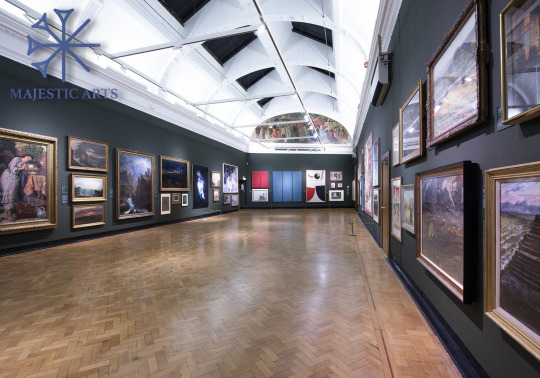


Majestic Arts were founded with a mission to provide a full 360-degree range of services in the art industry. The chief task of Majestic art is to perform all art-related services at a higher level.
#old indian art paintings#oldest islmaic art#Postmodern Art#Modern Art#Renaissance art#Islamic art#Indian art#Medieval art#Facilitating art gallery#Locating Masterpieces#Restoration art#Antique Etchings#Antique Miniatures#Antique Oil Painting#sculpture art#history of art#culture artwork#art & culture#international art gallery#luxury art gallery#oldest sculpture#oldest art#antique art gallery#famous art gallery#Majestic art art gallery#Majestic art#art gallery
0 notes
Text
Lily and James — the alchemical Queen and King. Lily is the main symbol of the entire saga.
In Harry Potter, there are two levels - the mundane and the symbolic. On the mundane level, Lily is a character with her own strengths and weaknesses. On the symbolic level, Lily is the main symbol of the entire saga. Perhaps that's why there's so little talk about her because symbolically Lily is what everyone strives for, everyone searches for but cannot find. Harry learns more about Lily only before the final battle, and there's a reason for that.
It's no secret that HP books are heavily laden with alchemical and Christian symbolism. I'm not religious, and to me, all these symbols are just cultural codes that have had a significant influence on almost all classic literature and art.

Philipp Otto Runge, Chagall, Goethe — they're all alchemical codes
Firstly, alchemy is not about literally turning lead into gold, it's a path of spiritual development, a path of transformation, a "hero's journey," the journey of the Son returning to the Father. Alchemical transformation is described in the text "The Chymical Wedding of Christian Rosenkreutz." This is the third manifesto of the Rosicrucian Brotherhood.
So, lilies are a very ancient symbol.
According to Jewish legends, the lily grew in Eden just at the time of Eve's temptation by the devil and could be defiled by him, but even amid temptation, it remained as pure as it was, and no dirty hand dared to touch it. In early medieval depictions, Christ was placed against a backdrop of lilies or in the lily flower, seen as a symbol of the Virgin Mary. The orange lily often symbolizes the blood of Christ.
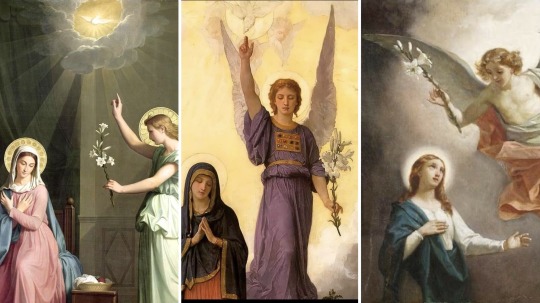
Symbolically, Lily is the love of God, a divine spark, and the blood of Christ itself, which was shed in the name of redemption and salvation to atone for the sins of all humanity. And what is the blood of Christ? In Christian tradition, the blood of Jesus Christ is a symbol of the life-giving and saving spirit of God.
By the way, lilies and roses were often confused in translations, and symbolically they are the same. Many suspected that the Rosicrucians' rose is a stylized version of the Egyptian and Indian flowering lotus, and the lotus has often been considered a water lily (they are different, but symbolically they merged). But calling the main character Rose would be too dull and obvious a reference.
Lily - symbolically, she is both the mother of Christ and the Spirit of God herself, the bearer of divine love, to which all seekers are drawn. This is not the only meaning, but for now, it's enough.
God is love, says John the Apostle. (Remus John Lupin, hehe. It was absolutely unnecessary to know his middle name. It's intentionally inserted because each of the marauders, except Sirius, by name signifies one of the disciples closest to Christ. Sirius is a separate story, he signifies something completely different.)
And who is drawn? Well, primarily we see two - James and Snape.
One of the most important things we learn about James is that he's a deer. The deer is a well-known symbol. In myths and folk beliefs, the deer was associated with the soul's aspiration to heaven and purification.
"As the deer pants for streams of water, so my soul pants for you, my God" Ps. 42: 1
In the Alexandrian "Physiologus," there's an ancient enmity between the stag and the serpent. The serpent hides from the foe in the clefts of the earth, but the stag, with the help of water, draws out the serpent and defeats it. (Water has always been a symbol of the serpent, even in Slytherin's element water, but the stag fights the serpent not with ordinary water but with the water of baptism. The snake has another important meaning for alchemy, but more on that later.)

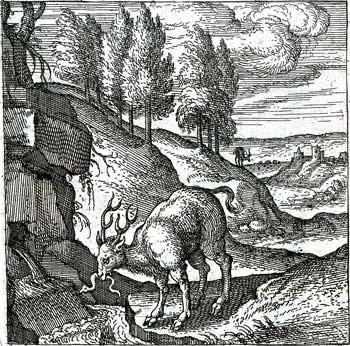
Snape belongs to the Serpent, to secret knowledge, occult knowledge, "philosophical" reason, dark magic, which has always been contrary to the divine nature in Christian understanding and originated from the devil. James belongs to the Lion and the Deer.
The Lion is a typical alchemical symbol. Also, the Red Lion is Christ. Gryffindor embodies the soul's aspiration towards light and transformation, towards salvation. By the way, St. Godric (the hermit) also had his own pet deer, which he saved.

The deer seeks love, the spirit of God, the divine spark, God Himself, and in this persistent pursuit is shown James's path, as a seeker and as an alchemist. The Potters — if not alchemists themselves, then at least from the lineage of alchemists — the Peverells (The symbol of the Deathly Hallows is an alchemical-masonic symbol). And this means that the Potters are at least seekers; in their souls, there is a desire to find the divine and undergo transformation. The Potters have a strong hatred for the 'serpentine essence' of evil, and this is what needs to be transformed. (By the way, the graveyard is located near St. Jerome's Church. Besides translating the Bible into Latin, Jerome also healed and tamed a lion).
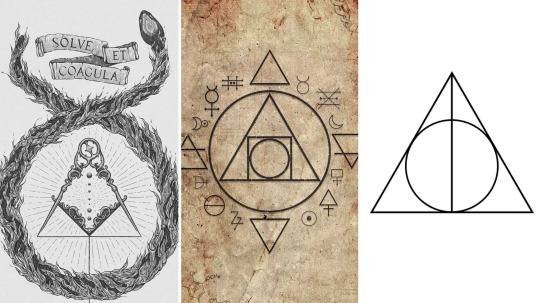
Masonic-alchemical symbol. Symbol of the philosopher's stone. Symbol of the Deathly Hallows. Solve et coagula is a principle of alchemy meaning "dissolve and coagulate".
An alchemist is a gardener, and this is another interesting reference to James and Lily. The way James tries to find an approach to Lily is an alchemical process. The alchemist tends to the Garden. In Vrisvik's Great Work (the Magnum Opus), it appears as the Garden of the Wise. The Gates to the Garden of the Wise for the Chosen become the process of dissolving "our Substance." James manages to approach Lily only when he dissolves his Ego. The Ego is the main enemy on the path to transformation.
The tradition of "hermetic gardening," that is, "cultivating the flowers of Wisdom in one's garden," becomes a leading line in alchemical symbolism. James cultivates wisdom.
While Snape cultivates "dark knowledge," although his soul also strives for light and love. But Snape is still too captured by his Ego, too captivated by base emotions, a thirst for revenge, recognition, or power, a craving for "secret knowledge." He cannot resist it, no matter how much he may strive for Lily, for the divine transformation of his spirit, and James, still dwelling in his Ego, instead of showing mercy to Snape, pushes him further away. The stag fights the serpent, but God is love. Ultimately, Snape temporarily closes off the paths of alchemical transformation for himself.
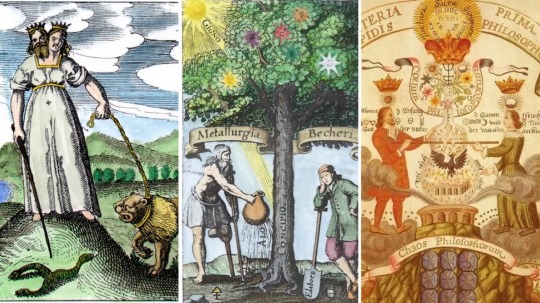
The Rebis is the end product of the alchemical magnum opus or great work. The lion must dissolve the serpent. Hermetic gardening. The alchemical wedding: the Queen and the King.
But besides all this, the deer is also a symbol of eternal renewal and victory over death ("The last enemy that shall be destroyed is death" 1 Corinthians 15:26 ). A symbol of Christ. His constantly renewing antlers represent eternal life.
In the original Greek of the New Testament, the names Jacob and James are variants of the same root—Yaaqob. James is an active force, a seeker, an investigator, a supplanter. James the Great was of a rather impulsive character, but everyone was also amazed by his courage, he was the only one who acknowledged Christ as the Messiah. And he is the only apostle whose death is described in the New Testament. He dies at the hands of King Herod, a cynical and evil king who was willing to murder babies for his purpose. James also dies at the hands of Voldemort, who is willing to kill a baby for his purpose.
Moreover, it was Saint James who was considered the heavenly patron of alchemists. His tomb was located in Santiago de Compostela, which was the oldest center of adepts. It was there, in 1378, after twenty years of unsuccessful attempts to decipher the Book of Hieroglyphic Figures, that Nicolas Flamel, the most famous alchemist of the Middle Ages, went. By the way, Shell Cottage... the scallop shell is a symbol of the apostle James and the "trademark" of the Way of St. James. Shell Cottage is also alchemical. It is there that Harry sees the symbol of the Deathly Hallows around Lovegood's neck.

James is a seeker. Lily is a symbol of the divine spirit, sparks, transformation. That to which all must ultimately come, that which must change in our world in the image of God. But for now, our world is seized by evil, by the antichrist. To defeat death means to defeat the antichrist in one's soul.
James finds Lily. The Soul finds the Spirit. The Spirit descends into the Soul. The King and Queen marry—and a new life is born, another hero capable of defeating the evil that has engulfed the world, capable of cleansing the world of evil. The connection between Harry and Christ is no secret to anyone.
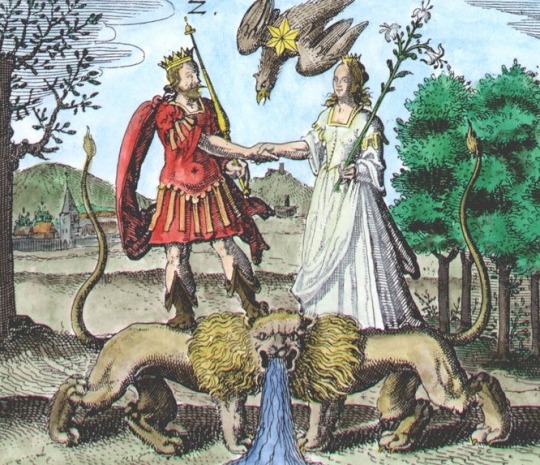
The power of love conquers death. A rune appears on Harry's forehead—Sowilo rune—the victory rune, the sun rune, the irreversible rune. It symbolically serves as the key to the world of Alfheim—the world of the light elves, that is, the bright ideas, the prototypes of the buddhial plane, the ideality in this world.

The key to God. Harry becomes marked. His scar is a reminder to him that he came into this world not just by chance, but to destroy evil. And coming into this world, materializing, a person invariably receives a particle of the antichrist within himself. That's how this world works. Evil is in the soul of each of us, and through the Great Work, a person must purify himself.
And none can live while the other survives, because they mutually exclude each other by their very nature. Christ and antichrist.
But Harry has a difficult path ahead, the path of the Great Work before he can achieve victory. And that will be the theme of all 7 books, 7 years — exactly 7 days is the duration of The Chymical Wedding of Christian Rosenkreutz for the transformation oh his soul, for victory over death.
86 notes
·
View notes
Text
Re: Historical accuracy in fiction
Tl;dr: it is not your job as a fiction author to provide complete historical accuracy. It is your job to evoke a time period and communicate it. Don't get bogged down in research unless you really want to.
First of all, this is my disclaimer: I am talking about the kind of things I like to read and write. I am speaking as a historical fiction fan, author and lover of history. This is my personal taste.
Perfect historical accuracy in fiction is massively overrated. In the past have gotten stuck on writing historical fiction pieces because I felt I needed to research more. This killed my story. The piece of art that could have been amazing sat languishing on a hard drive forever.
I do not think historical fiction needs to be stunningly accurate. In fact, it's easy to see when an author has clearly over-researched their book: it reads like a history text that talks about topics your average person would have never even thought about.
Example:
What an author I read recently thought a 1st century Roman citizen would think about: Ah yes, I remember the British campaign like it was yesterday, even though it was ten years ago, in AD 61. Nero was emperor then....etc.
Me, when I think about something that happened 10 years ago: Shit, that was 10 years ago? Wait, was David Cameron PM then?
(And I know how to read and use Google.)
I'm not saying "don't research the time period you are writing in". I'm saying "research the time period you are writing in as much as you feel like doing, then forget most of it when you get in your character's head, except for what might be meaningful for them".
It is not necessarily the purpose of historical fiction to give readers a detailed and realistic version of the time period. All you really need to give them is the vibes that make them feel as though they're in that time.
I just saw a post that explained how Medieval Europeans had access to spices we might usually associate with Indian cuisine. But is that what people would expect to see in a story set in Medieval Europe? No, and you don't get to put in a little "um, actually" author's note explaining every little detail that feels incongruous but is "technically" accurate. It just feels incongruous.
However, am I going to give my Indian character who lives in London in the 1930s access to curry spices? Yes, because he'd look high and low for them and I bet he'd find a good grocer somewhere in London at that time. I haven't researched how realistic that is, and I don't really care. It will still feel in-touch with the setting, and that's all I care about.
Ever since I gave up on perfect historical accuracy, I have written so many more stories in historical settings, and I love the hell out of them. Would a Louisiana jazz band tour in the UK in 1923? Maybe. But I am definitely putting a Louisiana jazz band in my novel set in the UK in 1923 because people want to see jazz in the jazz-age novel! And so do I!
The key thing is, I've only done the level of research that I'm interested in, enough to get me comfortably embedded in the time.
The fiction author's job is to deliver on the promise of the premise. Don't get caught up accidentally writing non-fiction!
You don't have to "put in your research" to write a historical novel. You get to put in as much research as you want to, and you get to disregard the stuff that doesn't spark joy, because it's your story.
I'd love to talk about this more. Historical fiction fans, what's your taste? Have you ever read anything that felt over-researched, or anything that was under-researched to the point of taking you out of the immersion? Let me know.
37 notes
·
View notes
Note
It's really fascinating to see just how deeply seeded the legend of Alexander the Great was and is culturally and mythologically. There are depictions of him from across different cultures and genres (ie Persian, Mongolian, Indian, Medieval manuscripts, renaissance painting etc). I've come across legends and depictions of him diving in a primitive submarine, being carried across the sky by griffins, jousting, and even finding the garden of Eden! When you think about it, its basically fan-fiction about him, so you're kind of carrying on the tradition with "The Lost Queen" 👀...
On that note, you know how Reader sees her name in the history book right before she goes back in time? I imagine Reader would become a sort of legend in her own right, by the oh so beloved wife and Queen of Alexander the Great, but also because no one can pin down her origins, creating an air of mystery and romance. Was this "Lost Queen" a princess from one of the many cities he conquered? A nymph? An angel? A peasant girl Alexander fell in love with on the spot? The jury's still out.
I'd also imagine that historians and artist would gloss over or forget the more... problematic aspects of the relationship and lean heavily into the "deeply in love with and devoted to" bit. The 'great romance' between Alexander and Reader will be depicted in the art of numerous cultures and become an especially popular motif in the renaissance. A love story for the ages! Come the 21st century, there will be numerous documentaries produced and youtube videos made trying to figure out the origins of this 'Lost Queen'. Some may even jokingly-but-not-jokingly suggest that maybe she was a time traveller!
Of course, when and if Reader, I imagine it will be a while before she can wrap her head around the fact of being a historical icon. This girl will have gone through a lot of shit.
Sorry if this was long. I'm just really intrigued by the whole thing 😁!
-- O-
👀👀👀
There are many legends about Alexander the Great, some even mentioned in the Bible, however subtly.
I just thought about that! Y/n will be like a legend, the owner of the stone, the Queen who disappeared and was so loved by the great conqueror. Of unknown and even mythological origin for some, little is known about it. The only official information was about how much Alexander loved her, loved her so much that he almost destroyed the city of Babylon - well, I can't say more, but here's something for you to think about.
I can see that there are statues of her throughout the conquered world, made by order of Alexander to leave her love eternal, her beauty eternal. These statues are the only clues as to what she looked like, although the features are not entirely true.
There is no doubt that their "romance" will be embellished and used as the basis for various forms of art. Nobody knew about the toxic part, the obsession and the terrors, but about how much Alexander loved his Queen and how much she must love him.
Imagine when Y/n goes back to his time and discovers all this? About how his suffering was written down in history as something so beautiful and romantic. The poor girl has been through so much shit and still has to deal with being billed as Alexander's "Beloved Queen"... And the historians and scholars trying to figure out how and why it disappeared...
I loved reading your thoughts on it and feel free to send more if you want! ❤️❤️
~ Lady L
48 notes
·
View notes
Text
FemLit 0601 - Queening and it's historical perspective
Queening is, in the sado-masochistic pantheon of arts, the use of the male face, mouth, and nose and tongue, as a substitute for sexual intercourse and masturbation, by the dominant woman.
It places the man in the most slavish, subservient position, under the woman’s buttocks and crotch. She sits on his face, or has his head trapped between her thighs. The whole event is devoted to her pleasure, her orgasms, and her time schedule. The man’s pleasure or pain, satisfaction or frustration, desires or fears are of little importance, if any. The woman’s clitoris, vulva, labia and vagina demand service.
This thrilling, delicious sexual practice has an ancient and traditional history. Ladies of medieval households often had pages provide them with mouth, lip and tongue service under their skirts while their husband were absent, thus remaining, technically faithful. Many a young boy had his first lessons in. sex with his head under Madame’s backside, with her quim vigorously riding his face. Many young girls still virgins, enjoyed orgasms on a male servant’s mouths as the earliest sexual experiences. In ancient Chinese courts one long tongued, trained male slave was used by female royalty and court ladies as casually as if they were going to the lavatory. The slave would be summoned, face-fucked then dismissed casually and serenely. In old Japan, brothels would provide male victims for such use by visiting, paying women and girls.
Mouth and tongue sexual service to the female genitals is ‘cunnilingus’ or ‘cunnilinctus’ literally cunt licking/ sucking. Queening properly places the woman on top of the male face, using it ruthlessly and selfishly. The lady commands, the man obeys. Having the male slave erect, frustrated and unsatisfied adds to the sadistic pleasures enjoyed by the woman. In ancient Persia, cleverly constructed chairs were known as man face stools with the male face replacing the seat centre. Ladies could lift their skirts, sit down, cover the scenario with those skirts, and with gentle rhythmic, firm hip and buttock movements enjoy private little orgasms even when others were present. Old Indian pornographic graffiti depicts scenes like that, with gowned girls, obviously in ecstasy, riding a male face while gazing at an enormous male erection.
In more recent, Western times governesses and nannies have been recorded as teaching their young male charges just how to please their crotches with their tongues. Many a frightened, cowed Georgian or Victorian boy knew intimately the underside of Madame’s skirts and felt the vice-like grip of her gartered thighs round his head. Masquerading as a punishment and usually followed or preceded by a whipping, the queening would take place in conditions of discipline and severity. The curt command, the superior, unsmiling demand would be followed by a rustling lifting of black, voluminous skirts, the stripping off of Madame’s panties and the heavy, fleshy hot damp descent of her buttocks and crotch onto the boy’s face. Heaven help him if Madame did not orgasm satisfactorily. A savage whipping would follow.
Even down in the servant’s quarters, the youngest male servant would find his head trapped under housemaids’ skirts. Cruelty seems to have been part and parcel of queening procedures in olden times.
‘Queening’ by definition, requires a dominant, demanding woman and a subservient, obedient man. The woman must be concerned only with her personal pleasure and satisfaction. His mouth, lips, tongue and nose are merely live tools there to pleasure her labia, clitoris, vulva and vaginal passage. He must be trained, if necessary by painful punishment, in the proper use of his facial features. She must gain the maximum delight and orgasmic satisfaction without concerning herself with her victim’s possible distress, humiliation and discomfort. He is nothing more than a sexual toy or playing, as of no more importance than her lavatory pan, her sanitary towels, her dildo, her handkerchief, her lavatory paper, her condoms or contraception pills, or her vaginal douche - all quite necessary to her private sexual and private well being, but all useable and disposable.
The choice of type of slave is up to her. She may wish to have a wimpish male twit under her backside and quim. She may find more delight in subduing a macho strong male. She may have a cuckolded husband to humiliate, taunt and sit on. She may have developed her talents as a schoolgirl, together with her girlfriends, taking the school wimp into the girls’ lavatory and taking turns in squatting on his face. She may have gained experience by dominating a younger brother, riding his face selfishly while their parents were asleep or away from home.
Some women like to have a mouth-dildo attached to their slave’s head, sticking up from his open mouth as a rideable accessory. This provides pleasant, full, vaginal passage orgasms, but prevents sucking and licking by the male victim. Other women blindfold their prone slaves, thus deleting any possible visual pleasure they might obtain. A few cruel ladies inevitably urinate on to his face after having orgasmed. Others enjoy demanding mouth service right after enjoying satisfactory adultery with a lover, thus making the victim more humiliated. Most talented queening ladies humiliate, taunt, torment, degrade and tease their victims before and after this enforced cunnilingus.
It is essential that the male slave is more than intimate with those parts of a woman’s body which require servicing by his tongue, lips and nose. Kneeling astride his face, with his eyes very close to her cunt, is a pleasant torment. He is able to see and fear each part of her sexual equipment, staring right up into her vaginal passage and memorising her clitoris, labia and vulva. Using her fingers to stretch her labia she is able to insist that he looks and learns. He must also examine her anus ;with respect, in case she decides to have his nose inserted into it.
She must teach him the way to kiss, lick and suck her sexually, with particular attention to her clitoris. He must suck and swallow her sex juices. To add a special thrill to her pleasure, she must make him afraid of her. He must be in awe of her. He must adore her. He must give her respect, and recognise her superiority. He must worship her genitals. They are his goddess, his fate, his destiny. His life is less important than a single orgasm enjoyed by her.
Riding the male face requires careful, skilful experience, as much as is required in learning to ride a horse. The hip and buttocks movements are the key to success. The careful placing of the cunt on the mouth or nose is, of course, essential, and might require some wriggling adjustment until the male’s service parts are properly positioned. It may be that the lady wishes to have his nose against her anal rose while his mouth serves her quim. She will, of course, be as rough and savage as she wishes at the moment she comes. At that moment she must not care in the least if he suffocates, or chokes. After satisfaction she can relax, still sitting on his face and enjoy a cigarette or a glass of wine. When she dismounts she will casually ignore the fool, dismissing him abruptly, sending him off to continue his housework, followed by taunts and insults. Perhaps she will lend him to the girlfriends!
The complete, perfect, mature woman always has two men in her life, one to fuck her normally the other to be queened by her, as her slave.
8 notes
·
View notes
Text
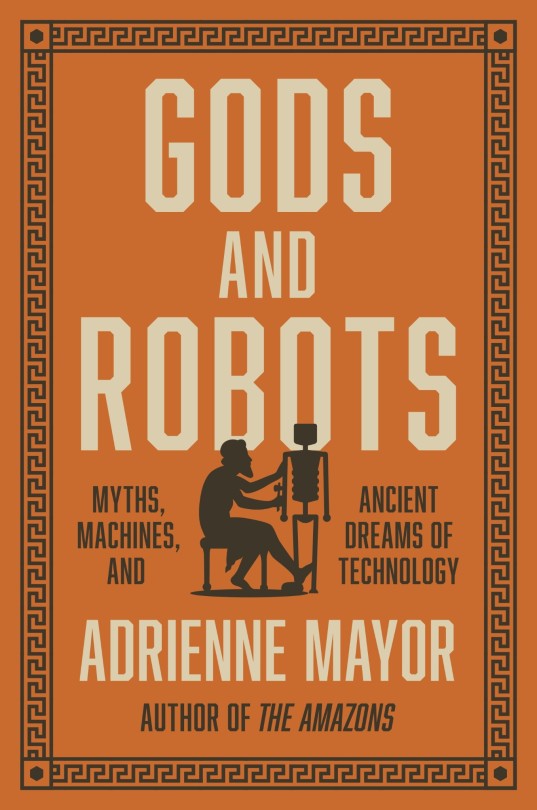
Gods and Robots: Myths, Machines, and Ancient Dreams of Technology. By Adrienne Mayor. Princeton University Press, 2018.
Rating: 4/5 stars
Genre: classics, mythology
Series: N/A
Summary: The fascinating untold story of how the ancients imagined robots and other forms of artificial life—and even invented real automated machines The first robot to walk the earth was a bronze giant called Talos. This wondrous machine was created not by MIT Robotics Lab, but by Hephaestus, the Greek god of invention. More than 2,500 years ago, long before medieval automata, and centuries before technology made self-moving devices possible, Greek mythology was exploring ideas about creating artificial life—and grappling with still-unresolved ethical concerns about biotechne, “life through craft.” In this compelling, richly illustrated book, Adrienne Mayor tells the fascinating story of how ancient Greek, Roman, Indian, and Chinese myths envisioned artificial life, automata, self-moving devices, and human enhancements—and how these visions relate to and reflect the ancient invention of real animated machines.As early as Homer, Greeks were imagining robotic servants, animated statues, and even ancient versions of Artificial Intelligence, while in Indian legend, Buddha’s precious relics were defended by robot warriors copied from Greco-Roman designs for real automata. Mythic automata appear in tales about Jason and the Argonauts, Medea, Daedalus, Prometheus, and Pandora, and many of these machines are described as being built with the same materials and methods that human artisans used to make tools and statues. And, indeed, many sophisticated animated devices were actually built in antiquity, reaching a climax with the creation of a host of automata in the ancient city of learning, Alexandria, the original Silicon Valley.A groundbreaking account of the earliest expressions of the timeless impulse to create artificial life, Gods and Robots reveals how some of today’s most advanced innovations in robotics and AI were foreshadowed in ancient myth—and how science has always been driven by imagination. This is mythology for the age of AI.
***Full review below.***
CONTENT WARNINGS: descriptions of myths that include violence and bestiality, mention of slavery
I first heard of this book when Adrienne Mayor was a guest on the Mindscape podcast. I found her ideas and arguments to be interesting, so I figured her book would expand on the concepts she explored on the podcast.
Overall, I think this book is an accessible intro for readers interested in classical studies and the history of science. Mayor writes clearly and without a lot of specialized terminology, so even if you're new to classics, you won't find this book difficult. I think the chapter about Talos was the most convincing and the most well-done, bringing together textual analysis and art history in a way I found intellectually pleasing.
As a scholar, however, I think this book could have gone a bit further, especially with its analysis of myths and texts. Mayor summarizes most of the myths she discusses, which is all well and good for situating the reader in the texts. But what I really wanted was more specific evidence and close reading: were there any interesting language choices used to describe this automaton? Did the Greeks have a certain vocabulary for artificial beings? As it stands, it felt like Mayor's textual analysis relied on general ideas, and while fine as a starting point, I really think it could have been pushed.
I also think there's some room to apply critical frameworks such as posthumanism and transhumanism theory. Applying such theories would enhance the meanings Mayor is trying to get at, but in all fairness, this may he beyond the scope of the book. Mayor seems to be relaying a history of ideas rather than trying to get at their interpretation, so maybe her book will function well as a springboard for other scholars and students to do this work.
Lastly, I do think this book could have been framed a little better to help me as a reader see some of the through-lines. There were moments when I wasn't sure how each of Mayor's examples fit in with the overall theme of "robots" or "artificial life," so maybe a better framing device would be the theme of biotechne rather than the sci fi approach that the book currently uses. Similarly, some further delineation between what constitutes "technology" versus magic (and even just "art") would have been helpful for seeing how each individual chapter builds upon the previous.
TL;DR: Gods and Robots is a good overview of the history of artifical life and technology in the ancient Greek world. This book is perhaps most useful as a springboard for further analysis, and historians, art historians, and literary scholars will find plenty to build on.
13 notes
·
View notes
Text

The Queen of Sheba and King Solomon with attendants. Unknown artist. Deccan, Central India, c. 1780.
#art#indian medieval art#early modern art#queen or sheba#king solomon#deccan#indian art#islamic art#south asian art#india#south asia#medieval art
103 notes
·
View notes
Text
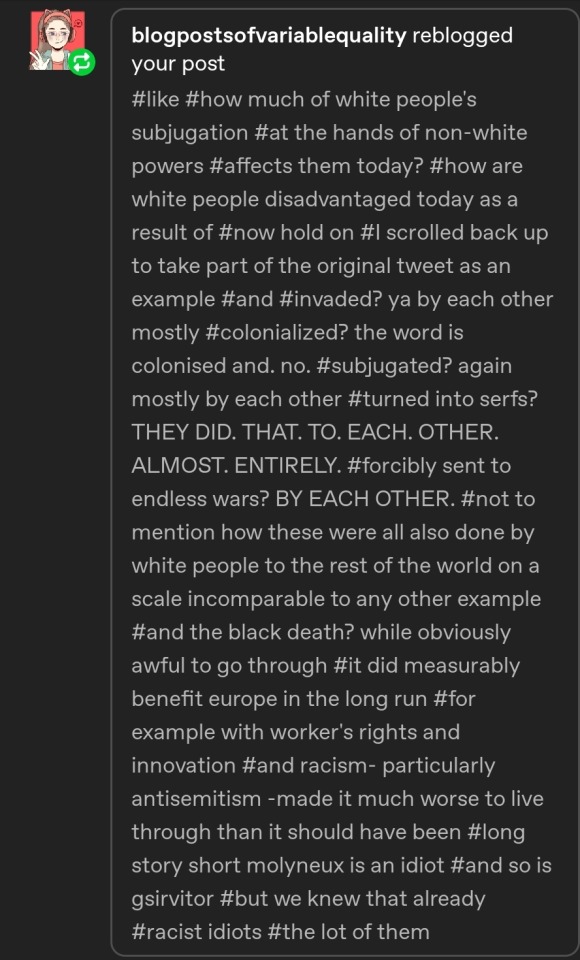
@blogpostsofvariablequality
How much does it affect them today? The same amount it affects non Europeans at the hands of Europeans, you can fill in the blank.
See, this is why I dislike the umbrella term of white people, sure it's an apt descriptor of a racial group, but it hides the nuance, the complexity of European history, culture and baggage.
The entirety of Eastern Europe has a multi thousand year history of being invaded by Asians and Middle Easterners, from the Turks, to the Huns, to the Ottomans, then there's the Greeks who have beef with the Turks and a history of Persian invasion, the entirety of Mediterranean Europe with the Barbary slave trade, the Mongol invasions, the black death, the Muslim conquests, etc etc, I can go on for hours, and that's not even bringing up the origins of the term Slave, which referred to a certain squating peoples now at war with eachother.
Every group is advantaged and disadvantaged by the modern world, especially in the west, for instance, a black man from Nigeria who moves to America is more often a higher earner than his American counterpart, why? Well it isn't disadvantages built into the system, it's the culture, for the Nigerian man his is a boon while the American's is a drag, why? One is built upon hard work, morals and looking to the future, while the other is dead set on looking at the past and wallowing in it, blaming all failures, not on one's self but on a nebulous bogeyman, the same way the Nazis blamed the Jews.
The same goes for any race, Europeans are outcompeted in their own nations by Asians and Indians, not because they're actually at any disadvantage other than what is self imposed, and that's the crux, those who screech about being perpetually disadvantaged by the "white" man, never work to improve themselves, to create a better future for their descendants, no, they just whine and beg for free handouts, as the Greeks say; "A society grows great when old men plant trees whose shade they know they shall never sit in."
Your statements mean very little, yes, the world is colonized, it has been colonized since time immemorial, over and over and over again, yes, Europeans did that to themselves, and others did it to them, just as Africans, Asians, Middle Easterners, etc have all done it to themselves and others since time immemorial, same goes for subjugation, slavery, etc.
And no, European colonization, when compared to the conquests of the past, were some of the least violent conquests in history, sure the land area claimed is incomparable, but the savagery, the brutality etc, pales in comparison to even just the Mongols and Huns.
Yes, the plague brought many benefits, such as modern labor movements, improvements in medicine and a new approach to life, much of the Italian Renaissance, even Shakespeare's drama to some extent, is an aftershock of the Black Death. Today its effects can be seen in the resistance to AIDS seen in some European populations.
However, the black death was only a benefit to the descendants of those who survived one of the darkest pages in European history, its consequences were profound. Besides the immeasurable pain and grief, traditional Medieval society was thrown into chaos and turmoil, economies were fractured, the Church lost status, and art and literature took a turn for the gruesome and bizarre, and Europe lost 30-60% of its population.
Ah yes, racism and antisemitism, something about this post has made people act quite racist, from calling for the subjugation of the white race, to comparing me, someone of Jewish descent, to the Nazis, this post has been a magnet for the mentally compromised.
However, I don't expect any critical thinking skills from, as you put it, racist idiots, so I say again, I don't care about the suffering of your ancestors, for you don't care about mine.
Good Day.
73 notes
·
View notes
Text
🙤 Enjoyable Things 🙧Rules: List five things you enjoy and pass it along!
Tagged by @shivunin and @demandthedoodles, thank you very much!!
(I am an indecisive ass so limiting myself to five is... a struggle)
(also am I the only one that started singing Favourite Things from Sound of Music...?)
Food. I know it will sound stereotypical as an Italian, but eating something I like gives me so much joy. I love eating and quite like cooking, even if I'm lazy.
I am a vegetarian with a lactose intolerance, so I end up eating vegan most often, and I'm currently having lots of fun in trying indian recipes which are naturally vegan (or easily so substituting ghee/butter with oil)! This Baingan Bharta recipe by cooking with Manali is something that always gives me so much joy, paired with some jeera pulao!
The sea/going swimming. I don't live close to the sea unfortunately, but I spent quite a lot of time in my youth. I can dive (used to reach 10m with no oxygen back then, now I'm terribly out of shape) and I LOVE snorkeling and seeing the fishes, and when I'll be rich I'll go diving in a cage to see some sharks from up close. All marine life gives me so much joy (the jellyfishes are so pretty! From a distance).
Medieval and Contemporary History. In case you were wondering, I love history and knowing more about it, but I'm very selective when it comes to remember it. The Middle Ages and the first half of the XX century (up until the Moon landing) are my favourite periods. Oh and also Ancient Greece. LOVE Ancient Greece (with all its flaws). I love love LOVE museums. And strolling around Medieval buildings is just!!! AAAAH! The older the better, I LOVE gothic cathedrals, and those old castles! And Oooooh I'm not the biggest graveyard fan but Irish graveyards? I'd be there sketching every day, I visited some when I was there and they were so peaceful. I love trying to read the inscriptions, and they lack the baroque kitsch that I never like. (Ireland is another thing that gives me joy, I wasn't there for enough but every time it was just... Bring me back please)
Sketchbooks. I am a art supplies hoarder, but sketchbooks are the one thing I like the most. I don't go outside without one in my purse, the fact that you have a book to be filled with what you want is just HHHHHHHHHHH so nice, it gives me so much joy. I tend to be a perfectionist, but I'm slowly trying to get rid of it and just... Do it for sketches, who cares if they're ugly.
I love to glimpse of personality in art. For both books and paintings, sculptures, movies, comics... I just love when you look at some form of art and realise the little quirks, what the author didn't like to do, or what they just love.
Tolkien going on for two pages to list plants in the Ithilien because he just loved greeneries. Pushkin being overly enthusiastic about feet (Pushkin was the biggest feet fetishist... And you can't hate it for it because the way he uses words...! AAAW.). Michelangelo that was perfect but couldn't bother to paint or sculpt women because he never saw a pair of boobs in his life. It's not highlighting mistakes, it's just... I think it makes authors human, and that much closer to us. What I don't miss about the academic field is this aura of sacrality about classic authors that's... Boring.
I just love to spot these little things and remind myself that big ass authors/painter/artists were just humans like you and me, with all their flaws and all the things they didn't really know how to do... but did anyway. You don't need to be perfect if MICHELANGELO can allow mistakes, no?
One more: anything Tolkien. There's just something so soothing about his writing and the way he shapes stories. I know the Silmarillion is heavy but... Consider reading his shorter books. Tree and Leaf is something that always moves me to tears, and please please do yourself a favour and read his children literature.
"Roverandom" is a tale he invented for his son Christopher, to soothe him when he lost his favourite toy at the beach. He invented the story of that toy, a dog, to explain to the child that oh no don't worry your toy dog, Rover, was actually a real dog turned into a toy by a wizard, he didn't get lost, he just got home! He loved you very much but he had to return a real dog you see! You helped him find his way back!
... sorry I had to include another, hope you don't mind. :P
And HELLO new followers I'm Arja and when they distributed synthetical abilities I was trying to pet a doggo.
(also doggos gives me so much joy. If the day is grey and a doggo by the street sniffs my hand and lick me or let me pet them, the day is instantly saved.)
Tagging: @salsedine @coloricioso @heniareth @melisusthewee @rowanisawriter @zenstrike @eowyn7023 (hi!) @rosella-writes @scribbledquillz @herearedragons @idolsgf
And YOU!
24 notes
·
View notes
Note
You know my biggest disapointment with breath of the wild was the Shiekah, they turned the VERY indian inspired group into bland ass ninjas and in the story that most revolves around the shiekah's agency that feels off, i suppose an indian group being servants of a european monarchy sucks but the erasure still leaves a bad taste in my mouth, what do you think?
I've never heard that the Sheikah were inspired by Indian art. Which does not mean it can't be a read-- I just haven't encountered it before. I WILL say that I noticed a LOT of architecture inspired by South Asia and India in Skyward Sword. But the dungeons and ruins in that game are rarely associated with a specific people, only 'the ancient past' and 'the goddess Hylia'. I wish we actually got confirmation that ancient Sheikah were associated with those ruins, rather than the only direct clue to Sheikah culture in that game being a time traveling exposition lady.
We had really few direct depictions of Sheikah architecture and customs before BotW, and in that game the 'ancient' Sheikah features were designed with the Jōmon period, the earliest known Japanese art and culture. The 'modern' Sheikah features were also very Japanese in aesthetic.
This kind of brings me to the point I want to bring up and reply to in your ask, which is that I take slight issue with the idea that Hyrule is a 'European monarchy.' I think it could be easy to read it that way where I live, because we tend to trust the aesthetics of stuff in a story to match up to locations in 'real life.' If we see a guy wielding a 14th century straight longsword we tend to assume the guy, within the bounds of style, is a medieval European dude. We don't expect him to lift his helm visor and reveal he's Japanese.
But for the same reason we look at anime characters and assume that many of them are probably intended to scan as Japanese to a Japanese audience, I think we need to extend that to Legend of Zelda. Even though the Hylian monarchy isn't wearing fashions that look Japanese, their nationalist myth throughout many games is set up to be extremely familiar to the domestic Japanese audience. Link and Zelda may be Blondes but the Sheikah analogs to a 'japan' themed culture are given white hair.
(Somebody else than me might have better insight into Anime Hair Colors.)
I live in the USA, 'the west', so by default narratives about imperialism and orientalism most accessible to me are going to assume whiteness and euro-centrism. But I feel it would be wrong to frame a piece of Japanese media as about whiteness, especially when it's clear that we can see the same type of stuff happen wherever racism and imperialism intersect.
There's only so much detail or nuance I can really have, given that I'm a white person in the anglosphere who's able to take Asian Literature in college, and Use Wikipedia, and Compare mythology, history, and news out of other countries to Video Games.
But yes, with all that said. It does put bad tastes in my mouth. Basically any depiction of entire cultures existing in some way to ensure a monarchy's security will do that, and the recent installment TotK extends to other fantasy races the horrible fate that has always been slapped onto the Sheikah: bound by an oath to serve Hyrule, Zelda and by extension, Link who paradoxically exists to both be the nation's tool but also the inheritor of everything in it.
#botw#totk#totk spoilers#totk critical#legend of zelda#the hylians are japanese and their imperial myth is japanese and their artifacts are japanese and the game is comfort food to japanese norm#and that doesn't make any of the issues better
29 notes
·
View notes
Text






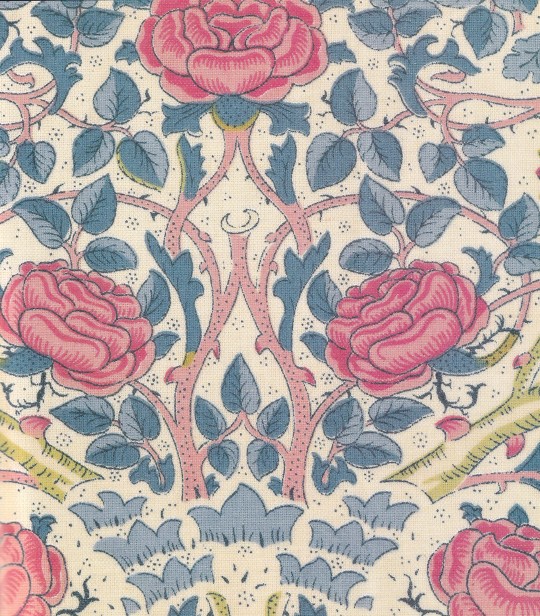



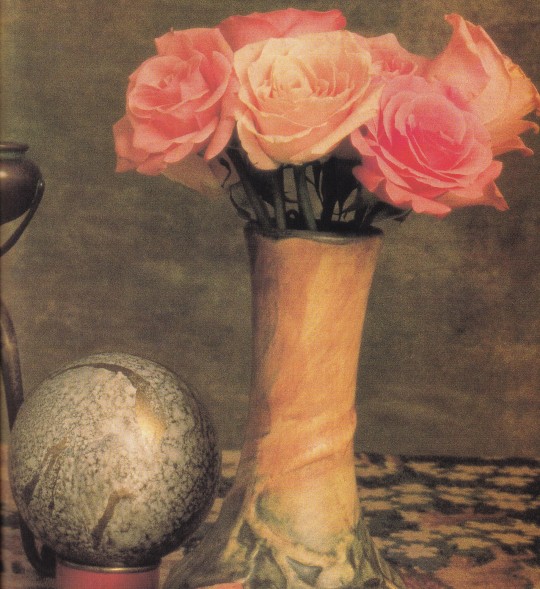

The Book of the Rose
Laura Cerwinske
Designed by Jean-Claude Suarès
Thames & Hudson, New York/London 1992, 160 pages, 24x24cm, ISBN 9780 500 015 353
euro 25,00
email if you want to buy [email protected]
No other flower has as legendary a history. The rose's dramatic combination of beauty and fragrance has made it a universal obsession, a symbol of spiritual love and physical passion praised in poetry, glorified in art, and venerated in every culture and religion.
The Book of the Rose is an exquisite devotion to the flower's ravishing and sometimes audacious presence throughout the centuries. It follows the cultivation of the rose from Persian and Indian gardens to medieval cloisters; from the War of the Roses to the Russian Court of Catherine the Great and the breathtaking gardens of the Empress Josephine. The rich selection of illustrations includes delicate portraits of Indian men and women presenting roses to their lovers, illuminated manuscripts of medieval rose blooms, and paintings that celebrate the rose's beauty - and its erotic intimations - by artists such as Redouté, Fragonard, Renoir, van Gogh, Fantin-Latour, and Beardsley.
The Book of the Rose also explores the rose motif in jewelry, porcelain and fabric, on furniture and in fashion, from the textiles of William Morris to the contemporary designs of Ungaro. In addition, a portfolio of glorious rooms illustrates the wide variety of rose themes in interior design.
For anyone who has ever grown a rose, given or received a rose, worn a rose pattern or scent, here is a lavish tribute to the world's most celebrated flower.
16/03/24
#The book of the Rose#Laura Cerwinske#Jean-Claude Suarès#Redouté#Fragonard#Renoir#van Gogh#Beardsley#Fantin-Latour#William Morris#Ungaro#rose themes in interior design#flowers books#fashionbooksmilano
5 notes
·
View notes
Text
Karate History & Box Art Redemption

About a year and a half ago, I mentioned Jordan Mechner's seminal 1984 game Karateka in a post about Sifu, a newly-released beat ‘em up with a similar martial arts theme and tough-as-nails difficulty level. Sifu's a good game that garnered a certain amount of scrutiny from people who pointed out that it was an interactive experience steeped in Chinese culture but developed by a predominantly white team. This is not inherently a bad thing (Sifu’s devs did a respectful job), but considering Western media’s track record of misrepresenting Asia as an exotic place full of Fu Manchu-mustachioed bad guys and subservient women, it’s always worthwhile to be cautious. At any rate, Sifu reminded me a lot of Karateka, another game by a non-Asian creator that owed its lifeblood to Asian culture...and even featured the main protagonist and his love interest as white on the box art, despite the fact that the game clearly takes place in medieval Japan.
The Making of Karateka, a just-released interactive documentary by Digital Eclipse, explains the logic behind this decision via extensive notes that detail every step of the game's creation. From what I can discern, the box art design doesn’t appear to have been Jordan Mechner’s call. (Though the playable Karateka beta included in this package reveals that Mechner had some wacky non-Japanese names in mind for the game’s villain and damsel in distress... Akuma and Mariko were once dubbed “Kratang” and “Tiger Lily.” Yikes!) Rather, publisher Brøderbund’s marketing team seems to have been the division that assigned artist Thomas Blackshear II to paint the cover, instructing him that the titular Karateka was supposed to look like "a young Chuck Norris" or "Luke Skywalker" while Mariko should resemble an "American blonde." Meanwhile, only Akuma was specified as "Japanese."


Brøderbund’s promotional strategy followed the typical American metality of the era: it's okay to portray a bad guy as a foreign race, but leading men and ladies should be white and ideally blonde. It didn't have to be this way, since Bruce Lee had dominated cinemas with Enter the Dragon only a decade earlier and proved that audiences could accept an Asian hero. But Brøderbund decided to go the safe route, despite the fact that Thomas Blackshear is a person of color renowned for his Black and American Indian paintings. (He also portrayed a decidedly unblonde and possibly Asian main character in his early cover sketches.)
My intention here is not to hate on Karateka or any of the individuals involved. The original Karateka game for the Apple II did, after all, feature white hair for its leading man's sprite that could easily be interpreted as blonde (though that was likely due to hardware color limitations more than anything else), and Brøderbund justified their decision by claiming they were inspired by the multicolored hair of Japanese manga characters. (Eh, sure.) Also, if we're being honest about it, Blackshear's final art is a beautiful composition even with the questionable racial depictions.
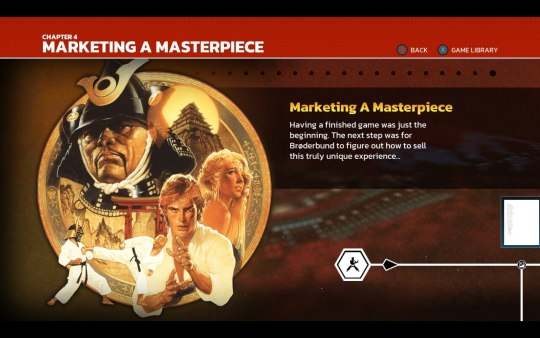
Rather, I'm fascinated with Karateka's box as an example of mildly problematic '80s promotion, and I love how we gain insight into its development thanks to Digital Eclipse' painstaking efforts with what they call the first in their "Gold Master Series" of playable documentaries. Aside from these marketing details, The Making of Karateka delves into Jordan Mechner's early life in precise timeline fashion, letting us explore planning documents, early rotoscoping footage and prototypes of not only Karateka, but the games that preceded it, including Mechner's take on Asteroids and a shooter he was trying to develop called Deathbounce. There's even glimpses at the bones of a platforming puzzle game that started out as Karateka II and would later evolve into Prince of Persia.
Just about every review of The Making of Karateka stresses how this package sets a new standard for preservation in the video game industry, a business that is terrible at chronicling its own past. I won't repeat these arguments too much other than to say that I fullheartedly agree. Behind the scenes featurettes used to be a thing when it came to games — as a kid, I remember being utterly absorbed with the "Making of King's Quest VI" footage that came included on the CD-ROM — but these days you're unlikely to see too many of them, especially for titles that were released decades ago. In a world where Nintendo has yet to localize Mother 3 and customers need to rely on emulation and all types of hacks to revisit old games, Digital Eclipse's commitment to curating digital museums dedicated to works like Karateka is an incredible worthy goal — possibly one of the most important goals that a video game company has ever embarked upon. I can't wait to see more volumes in the Gold Master Series, and can think of many potential entries off the top of my head. Pitfall! Ultima! Doom! Maybe even one day...Sifu? (Likely a stretch, but stranger things have happened.)


But going back to the discusson of art for a moment, one of the most monumental things that The Making of Karateka does is offer a "remastered" version of its title game, complete with impressive graphical flairs, a more managable difficulty level, and even...revised box art. While Thomas Blackshear's original Karateka painting is still displayed prominently throughout the package, when you go to select Karateka Remastered under the list of playable games, you'll see a new mockup box. No longer is Akuma a dehumanized Japanese baddie, no longer is Mariko an all-American girl, no longer is the titular Karateka Luke Skywalker. All three characters are Asian...and get this, the central Karateka is not only Asian, but blonde too.
In one swift stroke, The Making of Karateka not only captures history and chronicles its mistakes, but also revises them for a bright future. Take that, 1984 marketing.

Update: An earlier version of this article stated that the new mockup cover art was illustrated by Digital Eclipse in-house artist Mae Livingston. Mike Mika, the president of Digital Eclipse, reached out to me on Twitter to explain that while Mae was responsible for Karateka Remastered's in-game artwork, the actual box image was made via Midjourney, and the characters were tweaked multiple times to look more culturally appropriate. He added that this methodology was an experiment that Digital Eclipse does not intend to rely on in the future.
I have very mixed opinions on AI art, and I do wish this box had been created by a human. I don't know if I would've written this piece if I'd known that the artwork was made by Midjourney, frankly. Nevertheless, I appreciate Mike actually reaching out to me, and the ultimate message of this article still stands. I hope Digital Eclipse considers the power that an image like this holds — especially for multiracial people like myself — and chooses human artists in the future.
17 notes
·
View notes